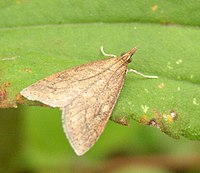피랄로이데아과
Pyraloidea| 피랄로이데아과 | |
|---|---|
 | |
| 유럽 옥수수 보어, 타조니아 누빌랄리스 | |
| 과학적 분류 | |
| 킹덤: | 애니멀리아 |
| 망울: | 절지동물 |
| 클래스: | 살충제 |
| 순서: | 레피도프테라속 |
| 클래드: | 둔각류 |
| 슈퍼 패밀리: | 피랄로이데아과 |
| 가족들 | |
| 다양성[1] | |
| 약 2,100개의 제네랄, 대략 16,000종의 묘사된 종 | |
피랄로이데아(피랄로이드나방 또는 코딱지나방)는 전 세계적으로 약 16,000종의 설명 종을 포함하고 있는 나방 슈퍼패밀리로, 적어도 설명되어야 할 종은 더 많이 남아 있을 것이다.[2] 그것들은 일반적으로 상당히 작은 나방이며, 따라서 전통적으로 파라피알레틱 미세조미료와 연관되어 왔다.
이 슈퍼 패밀리는 히블레이대, 티리디대, 알루시티대(플러스 티네오대), 프테로포리대, 피랄대 등을 포함했었다. 처음 네 식구는 이제 각각 뚜렷한 슈퍼 패밀리로 분리되어 있다.
요즘 피랄과는 주로 피랄대 센슈프티코와 크램비대로 나뉘는데, 두 집단 모두 단극성 집단과 자매 집단으로 나타나기 때문이다.[3][4]
일부 제네랄(예: Micronix 및 Tanaobela)은 여전히 쉬운 분류에 맞지 않고 크램비대 또는 피랄비대에 다양하게 할당되었다.
모든 레피도프테라 중에서 피롤로이드는 가장 다양한 생활사 적응을 보여준다. 대부분의 종의 유충은 잎 굴리기, 잎새 잎 채굴자, 보어, 뿌리 사료자, 종자 사료자 등으로 내부 또는 외부적으로 살아있는 식물을 먹고 산다. 어떤 종은 개미 둥지(우르티니)에 기생하여 살거나, 저울 곤충을 잡아먹거나, 벌의 둥지에서 살기도 한다. 아센트로피나의 유충은 물 속 생활에 적응하고, 특정 피시티나와 피랄리네는 매우 건조한 환경에 적응하며 그들의 유충은 저장된 식품을 먹고 산다. 다른 사람들은 캐리온이나 배설물과 같은 동물 배설물을 먹고 산다.
이렇게 다양한 생활습관으로 피롤로이드는 생물다양성 연구에 활용된다.[5] 일부 종은 경제적 중요성이 있다. 예:
- 쌀줄기 심는 사람(칠로 spp; scirpopophaga spp.)
- 풀벌레(크람비나에 다른 종)
- 인도식나방(플로디아간피델라)
- 유럽 옥수수 보어(오스트리니아 누빌랄리스)
- 인도-호주 코코넛 스파이크나방(티라타바 루피베나)
- 카카오나방 (에페스티아 엘루텔라)
- 지중해 밀가루나방 (Epestia Kuehniella)
- 왁스나방(아크로이아 그리셀라, 갤러리아멜로넬라)
- 쌀나방(코시라 세팔로니카)
- 비트 거미줄(스폴라데아 리커발리스)
- 유럽고추나방(Duponchelia fovealis)
- 레구메 포드 보어(Maruca vitrata)
- 가지 과일 재배자(Leucinodes spp.
참조
- ^ Nuss, Matthias; Landry, Bernard; Mally, Richard; Vegliante, Francesca; Tränkner, Andreas; Bauer, Franziska; Hayden, James; Segerer, Andreas; Schouten, Rob; Li, Houhun; Trofimova, Tatiana; Solis, M. Alma; De Prins, Jurate; Speidel, Wolfgang (2003–2020). "Global Information System on Pyraloidea (GlobIZ)". www.pyraloidea.org. Retrieved 2020-02-21.
- ^ Munroe, Eugene G.; Solis, Maria Alma (1998). "The Pyraloidea". In Kristensen, Niels Peder (ed.). Lepidoptera, Moths and Butterflies. Volume 1: Evolution, systematics, and biogeography. Handbook of Zoology. Insecta, Part, Volume IV Arthropoda 35. Berlin: Walter de Gruyter. pp. 233–256.
- ^ Minet, Joël (1982). "Les Pyraloidea et leurs principales divisions systématiques" (PDF). Bulletin de la Société Entomologique de France (in French). 86 (9–10): 262–280.
- ^ Regier, Jerome C.; Mitter, Charles; Solis, M. Alma; Hayden, James E.; Landry, Bernard; Nuss, Matthias; Simonsen, Thomas J.; Yen, Shen-Horn; Zwick, Andreas; Cummings, Michael P. (2012). "A molecular phylogeny for the pyraloid moths (Lepidoptera: Pyraloidea) and its implications for higher-level classification". Systematic Entomology. 37 (4): 635–656. doi:10.1111/j.1365-3113.2012.00641.x. S2CID 86208636.
- ^ Schulze, Christian H; Fiedler, Konrad (2003). "Vertical and temporal diversity of a species rich moth taxon in Borneo". In Basset, Yves; Novotny, Vojtech; Miller, Scott E.; Kitching, R. L. (eds.). Arthropods of tropical forests. Spatio-temporal resource use in the canopy. Cambridge University Press. pp. 69–88. ISBN 9780521820004.
| 위키미디어 커먼즈에는 피랄로이데아 관련 미디어가 있다. |
| 위키피아는 피랄로이데아와 관련된 정보를 가지고 있다. |
외부 링크
- Pyraloidea(GlobIZ)의 글로벌 정보시스템
- Solis, M. Alma (June 2007). "Phylogenetic studies and modern classification of the Pyraloidea (Lepidoptera )". Revista Colombiana de Entomología. 33 (1): 1–8.
- 뉴질랜드의 피랄로이드 나방의 모습



